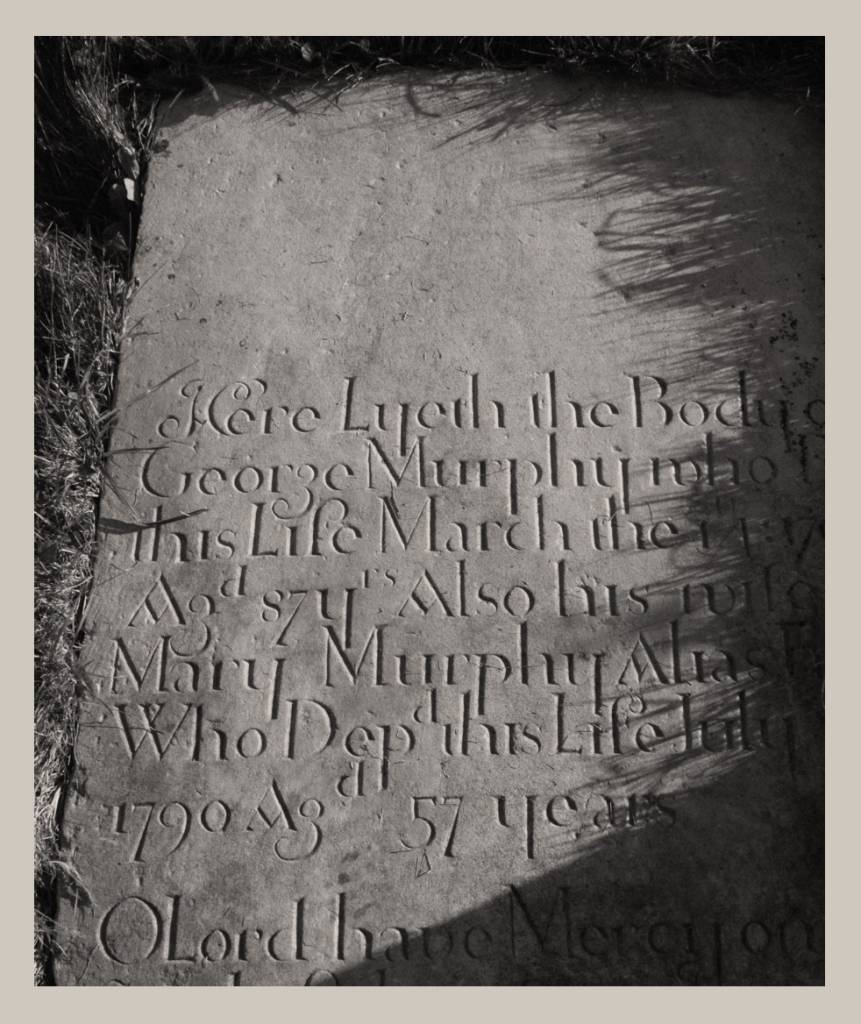NEW BOOK ON SAINT RYNAGH’S OLD GRAVEYARD, BANAGHER
An attractive new book on the history and memorials of Saint Rynagh’s Old Graveyard in Banagher has just been published. The book has 192 pages, almost 400 photographs and historical images plus a collection of essays and short articles on eminent souls buried there and on aspects of the site’s ecclesiastical history. The book is written by James Scully, a long-time student of Banagher’s history.
This substantial volume includes a comprehensive survey of 182 memorials ranging in date from 1576 to 1918. A transcription and description of each monument is given accompanied, where possible, by clear photographs. The outstanding quality of the pictures, taken by Peter Pilkington, Eoghan Broderick and the author himself, greatly enhance the engaging text. The twenty or so black and white photographs taken by Peter Pilkington, are outstanding, no more so than on the double spread devoted to the splendid box tombs of Anne and Mary Fox. The addition of a score of well-sourced historical images also helps to make the whole production an enjoyable read especially the colourful images highlighting the remarkable career of Captain William Bamford, an accomplished cartographer, draughtsman and watercolourist.

The lengthy introduction has ten short essays. The first of these explains the reasoning behind the main title ‘Forgotten Souls’ and elaborates on the methodology of recording and describing the memorials. The work of the stonecutter in general and then in particular in this graveyard, is well described and illustrated with images of the rich vernacular characteristics of many of the headstones. Minute features such as mirrored letters, ligatures and ampersands are explained and lucidly illustrated. A list of the placenames recorded is also given and while few of these were dramatically new, graveyard memorials are often overlooked as a source for toponymical studies.
Three short articles then recall historical episodes in which the graveyard was prominent. The first explores the impact of the cholera epidemic on Banagher in the 1830s, a short article recalls a poignant famine funeral in 1847 and then the story of the gradual closure of the burial ground between 1872 and 1924 is told in some detail. Two pages are then given over to a select ecclesiastical chronology of the site. This covers the period from the time of Saint Rynagh herself in the sixth and seventh centuries to the opening of a new graveyard in 1924 and is illustrated with five clearly reproduced maps from the seventeenth and nineteenth centuries. Two short essays by conservation architect, Eoghan Broderick and Galway City heritage officer, Jim Higgins treat the ecclesiastical history and archaeological importance of the site comprehensively. The introduction closes with a detailed map of the graveyard as it is today by Eoghan Broderick which will ensure that genealogists and other enthusiasts will easily locate their chosen memorials.

The alphabetical list of the memorials is then spread over 160 pages and contains numerous features on military personnel. Most notable among these is the biography of Captain William Bamford by the acclaimed U.S.military historian, John B. Hattendorf. Several biographies are enhanced with extracts from wills and funeral reports. Other historical characters and events that appear in the many notes in this section include Catherine Adlum, a victim of the flu pandemic in 1918; Nicholas Andrews of Drogheda and Shannon Harbour; Andrew Armstrong; Carteret A. Armstrong; Grisell Armstrong; Capt. John Casey; Master Eugene Collins; Duffys the Traders; Robert Flattery the Fenian sympathiser; the Fox sisters and the La Sainte Union school and convent in Banagher; John Harton the hero; Luke Harton the freemason; Hipwell’s, the eel weirs owners; Hannah Kennedy alias Banko; a fascinating letter to Mr.James Banko in August 1807; Sir John MacCoghlan’s will and tombstone; Thomas MacCoghlan, the last chief of the MacCoghlans; Martin McIntyre & The Harp Hotel; Barney McIntyre, the faithful groom of Anthony Trollope, the Victorian novelist; Private William McKeon; Thomas McKeon’s funeral; the poet Austin Clarke and the McKeon sisters; the McLoughlins of Cloghan; Captain William Winder and finally, the tragic death of William Woods. The many memorials of the Donahoe, Lantry, McIntyre, Miller, Molloy and Thompson families are all described in detail.
The closing pages carry an alphabetical list of the hundred or so persons whose names appear on a memorial under another surname. Remarkably sixty-five of these are women whose ‘alias’ or maiden name was inscribed on a monument, a practice that stopped in 1872. The final article entitled An Encounter with Banagher’s Faithful Departed, gives a full account of a creative event held in the graveyard, in 2019 where a large audience met with several of Banagher’s most prominent ancestors and were regaled with the trials and tribulations, tales and triumphs of their lifetimes. This piece is also well- illustrated
Mindful that many who are remembered in this work died in times of epidemic, pandemic or famine, the book is dedicated to all who work on the frontline during the current pandemic. The earnest aspiration that their efforts be not forgotten is both timely and appropriate.
The book was published by Offaly History with the support of the Heritage Office in Offaly County Council and the Creative Ireland Programme. The work was splendidly designed by Connie Scanlon and James Fraher of Bogfire, (www.bogfire.com).
Copies cost €20 each and are available from Paul Flynn’s Newsagent and Feeney’s Day Today Newsagency, both Main Street, Banagher, and from Buckley’s SuperValu, Main Street, Birr.
Postal orders to www.offalyhistory.com Further enquiries to James Scully 085 710 7569 or jsmeelick@gmail.com




